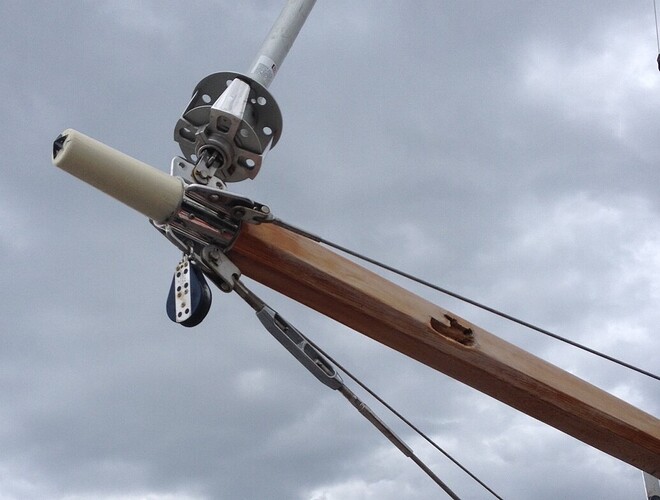I was finishing my pre-launch prep today on Haiku (ex Aura) by sanding the bowsprit with the hope of varnishing over the next few days. I decided to remove the small pulpit that screws into the sides of the sprit because it looked like it had been poorly bedded and discovered a sizable body of rot underneath the fitting on the port side, where the screw holes had acted as channels for water. Not a good thing to find when you are already late launching for the year.
Any thoughts on the repairability? It goes in about an inch. Could perhaps scarf in a repair, at least for this year? And for the longer term, what is the best way to replace the sprit?
I think a good scarf well done and well set in epoxy would work well for a good while. Careful attention to the design would be important. Epoxy is a wonderful material.
Andrew: Hi!
Meryl and I replaced Zygote’s bowsprit after discovering rot. In Zygote’s case, the rot was at the gammon iron. Working of the sprit at the gammon had cracked the varnish coat. Tropical rain had done the rest. We replaced the sprit - using carefully chosen teak and building the sprit by lamination.
That was partly because I was not confident about scarfing.
I now think that scarfing would work. And thereby add my voice to Stewart’s.
And I refer you to an article in the latest issue of Afloat (point your browser to: http://magazine.afloat.com.au/?iid=91152#folio=30 ).
Note the discussion of (1) maximum surface area (on p. 30); (2) choice of Epoxy (pp. 30 - 31); (3) the importance of saturating the surfaces with epoxy, of using many clamps, and of not tightening the clamps too early, for fear of squeezing epoxy away from the surfaces and thereby creating a dry joint (pp. 31 - 32); and that the longer the epoxy takes to cure, the stronger the joint (p. 32).
Cheers
Bil
nice article Bil, I made a new tiller and used epoxy and did not wet the wood sufficiently, to my complete disdain one of the ash mahog laminates came undone. I was rather undone myself.
Golly, Haiku ex-Aura is BCC 122, 2007! It sure didn’t take long for the fungi to do their thing, did it? Sam, at least in 1981, made the sprits out of laminated Douglas fir–a strong wood for its weight. A number of BCCs have had problems with the sprits and I would like to suggest that they could probably all have been avoided if the sprits had been sealed with epoxy. I know, it’s not “traditional”, but our hull and deck material isn’t traditional either. Water needs to be kept from contacting the wood grain and varnish is a very poor barrier, easily abraded and degraded by UV. A coat of epoxy on the bare wood, followed by primer and several top coats of paint will really protect the wood. Of course anything screwed into the wood needs to be well bedded with a good sealant.
The Afloat article mentions using an epoxy sealer, which penetrates better than regular epoxy, especially into end grain. Probably the way to go. 22 yrs ago I used West Systems epoxy on the bulwarks, taffrail, cockpit coamings, etc. which are Honduras mahogany. Also on the ash rudder cheeks and the Douglas fir sprit. The paint stands up well because water doesn’t get underneath it and into the wood grain, lifting everything off. We varnished everything for the first 10 or so years of Shaula’s life.
I’m a big fan of beautiful wood grain, but I don’t think it belongs on the outside of a boat that lives on the water. It takes too much time and elbow grease to keep varnished wood looking good and safe from the fungi. Our varnished mahogany bulwarks were gorgeous and non-boaters were always commenting on their beauty. Yeah, they looked like furniture, a wonderful dark red. After returning from a trip to Hawaii in 1985, I had to take them back to wood and revarnish them.
Varnish over epoxy does work–our ash tiller looks great–no evidence of the epoxy. We keep a cover on it when we’re not using it. I wouldn’t want to try to and keep the bulwarks’ varnish (over epoxy) up, although some folks can handle the (yearly?) job. Different strokes…
Dan Shaula BCC 59, 1981
